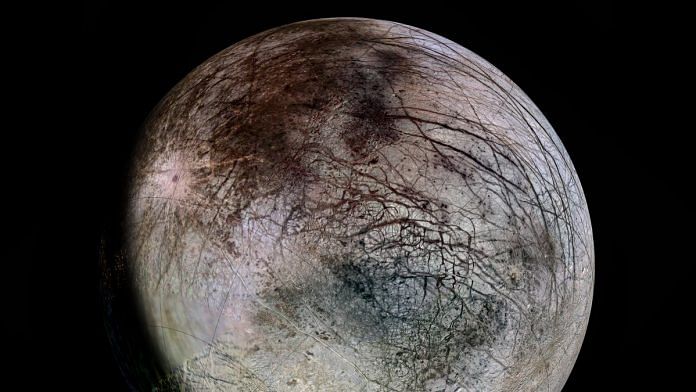Bengaluru: A new study has hinted at the presence of shallow pools of underground salt water under the icy shell of Europa, Jupiter’s sixth closest moon and the smallest of the four Galilean moons, making these pools a promising location in the search for life.
The findings were published in the journal Nature Communications this week.
The findings of this new study are based on a comparison with data from the Greenland ice sheet, which contains structures and geometry similar to what is found across the icy Jovian moon.
Double ridges, which are symmetrical mountain-like structures running hundreds of kilometres in length, are a geographical feature commonly found in Greenland. These double ridges flank a shallow trough or valley. The authors of the new study have managed to identify a double ridge in Greenland uncannily similar to those found on Europa.
Studying the formation of the ridge indicates that it occurred over successive periods of fracture of shallow water, refreezing, and pressurisation cycles. Citing the fact that this unique geometry is also found on Europa, the authors of the study suggest that if a similar process is responsible for the formation of double ridges there, it could indicate the presence of shallow brine beneath the surface on the moon.
While shallow water processes have been suspected on Europa, if the findings are confirmed, this could mean that they play a more dominant role in shaping the moon’s surface features than previously believed.
Also Read: Study reveals how temperatures in Neptune’s atmosphere fluctuated over past two decades
Stanford study
The study was spurred by images of Europa’s global double ridge features, which the authors noticed were similar to a smaller feature they had noticed in northwest Greenland.
Radar observations had revealed that the Greenland ice sheet’s ridge sits over a layer of shallow refreezing salt water. It is located within a percolation zone, where the part of the ice sheet exposed to the surface contains a layer of porous snow which compacts to solid ice only tens of metres below the surface. This porous ice melts during summer, creating surface meltwater that percolates into the fluffy ice, refreezing below and forming layers of temporary ice sheets.
Water flows down to lower layers through fractures or cracks in ice. As the ice is not hard, this water leaks off into the sides of the fracture, weakening the whole region structurally, instead of propagating through ice as a longer fracture.
In turn, as this leaking water refreezes on either side of the fracture containing water, the newly formed crystallised ice expands, causing uplifts that result in the formation of mountains or ridges which flank the fracture.
The authors of the study note that there are many similar features observable on Europa, whose surface is contiguously covered with fractures and ridges.
Snowball moon
Europa is primarily made up of rock and has an outer 25 km-thick crust of water ice, making it home to the smoothest surface of any solid astronomical body in the solar system. It is also the sixth largest moon in the solar system, and is slightly smaller than Earth’s Moon.
Researchers have long suspected that the Jovian moon harbours an underground liquid water ocean, which interacts with strong radiation from Jupiter. The warmth of the ocean is provided by tidal flexing due to Europa being subject to strong gravitational forces in its neighbourhood that tug at it from all directions, heating the interior.
The surface of Europa shows a series of crisscrossed dark streaks on the white ice called lineae. These were likely formed during a series of eruptions of warm ice that exposed the warmer, wetter layers underneath. This is similar to the formation of oceanic ridges on Earth.
While there is no ice volcanism or cryovolcanism actively observed on Europa, it is believed that the process does occur. There have also been observations of plumes of water vapour on the Jovian moon. If these findings are confirmed, it could indicate that shallow water process have been more dominant in shaping the surface features of the moon than previously believed.
Europa has shown evidence of internal warmth and activity, and the presence of shallow pools of water furthers the possibility of the icy body being a potential habitat that could support life.
The first dedicated mission to Europa, NASA’s Europa Clipper, is set to launch in 2024. It will arrive at Europa in 2030 to study it in detail.
(Edited by Amrtansh Arora)
Also Read: Wellbeing sessions can improve mental health in extreme isolation in Moon-like habitat: Study



